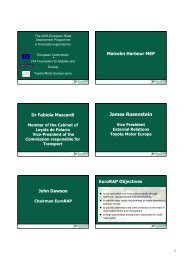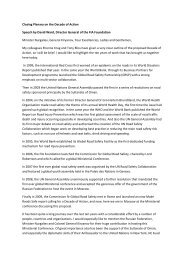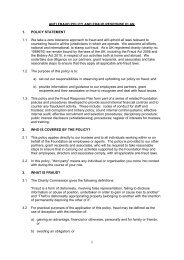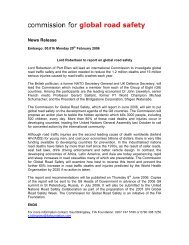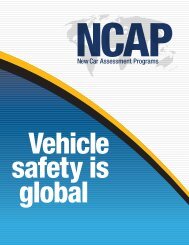The EU policy on CO2 and cars - International Transport Forum
The EU policy on CO2 and cars - International Transport Forum
The EU policy on CO2 and cars - International Transport Forum
You also want an ePaper? Increase the reach of your titles
YUMPU automatically turns print PDFs into web optimized ePapers that Google loves.
<str<strong>on</strong>g>The</str<strong>on</strong>g> <str<strong>on</strong>g>EU</str<strong>on</strong>g> <str<strong>on</strong>g>policy</str<strong>on</strong>g><br />
<strong>on</strong> <strong>CO2</strong> <strong>and</strong> <strong>cars</strong><br />
Günter Hörm<strong>and</strong>inger<br />
European Commissi<strong>on</strong><br />
FIA Foundati<strong>on</strong> - Towards a Global Approach to<br />
Automotive Fuel Ec<strong>on</strong>omy – 2008 Symposium<br />
Paris, 15-1616 May 2008<br />
1
Overview<br />
• Part 1: Background<br />
Internati<strong>on</strong>al comparis<strong>on</strong><br />
History of <strong>CO2</strong>/<strong>cars</strong> in the <str<strong>on</strong>g>EU</str<strong>on</strong>g><br />
Key c<strong>on</strong>cepts used in the proposal<br />
• Part 2: <str<strong>on</strong>g>The</str<strong>on</strong>g> Proposal<br />
Key elements<br />
2
A global comparis<strong>on</strong><br />
Source: Internati<strong>on</strong>al Council <strong>on</strong> Clean <strong>Transport</strong>ati<strong>on</strong><br />
3
History of <str<strong>on</strong>g>EU</str<strong>on</strong>g> <str<strong>on</strong>g>policy</str<strong>on</strong>g> <strong>on</strong> <strong>CO2</strong> from <strong>cars</strong><br />
• UNFCCC 1992<br />
• Community strategy to reduce <strong>CO2</strong> emissi<strong>on</strong>s from<br />
passenger <strong>cars</strong> <strong>and</strong> improve fuel ec<strong>on</strong>omy<br />
(COM(95)689)<br />
5 l/100km petrol, 4.5 l/100km diesel (=120g/km)<br />
3 pillars: voluntary commitments, fiscal measures,<br />
c<strong>on</strong>sumer informati<strong>on</strong><br />
• Voluntary commitments<br />
ACEA: Feb.1999, target date 2008<br />
JAMA, KAMA: April 2000, target date 2009<br />
Objective 140 g<strong>CO2</strong>/km<br />
4
Revised CO 2 <strong>and</strong> <strong>cars</strong> strategy<br />
COM(2007)19<br />
• 120 g delivered in 2012 through an “integrated<br />
approach”.<br />
a) 130 g <strong>on</strong> the vehicle side;<br />
b) 10 g through additi<strong>on</strong>al measures <strong>on</strong> car comp<strong>on</strong>ents<br />
(tyres, airco etc.) <strong>and</strong> increased use of biofuels.<br />
• Legislati<strong>on</strong><br />
5
Revised strategy <strong>on</strong> CO 2 <strong>and</strong> <strong>cars</strong> strategy (2)<br />
• <str<strong>on</strong>g>The</str<strong>on</strong>g> automotive value chain remains at<br />
the heart of the new strategy…<br />
Vehicle technology improvements (engine,<br />
transmissi<strong>on</strong>, hybridisati<strong>on</strong>, vehicle body etc.)<br />
Efficiency requirements for air-c<strong>on</strong>diti<strong>on</strong>ing<br />
systems<br />
Tyre pressure m<strong>on</strong>itoring systems<br />
Low rolling resistance tyres<br />
Gear shift indicators<br />
M<strong>and</strong>atory fuel efficiency targets for lightcommercial<br />
vehicles<br />
6
Revised strategy <strong>on</strong> CO 2 <strong>and</strong> <strong>cars</strong> strategy (3)<br />
• …with increased involvement of other<br />
stakeholders<br />
Fuel suppliers (low carb<strong>on</strong> c<strong>on</strong>tent fuels – e.g.<br />
biofuels)<br />
Member States (taxati<strong>on</strong>, fiscal incentives, traffic<br />
management, infrastructure etc.)<br />
C<strong>on</strong>sumer awareness (e.g. amending the labelling<br />
directive, code of c<strong>on</strong>duct for « sustainable »<br />
advertising)<br />
Drivers’ behaviour (e.g. eco-driving)<br />
• Accountability <strong>and</strong> m<strong>on</strong>itorability are needed for<br />
different elements to make a quantified c<strong>on</strong>tributi<strong>on</strong><br />
7
Revised strategy <strong>on</strong> CO 2 <strong>and</strong> <strong>cars</strong> strategy (4)<br />
• Review in 2010 to assess potential for progress bey<strong>on</strong>d<br />
120g/2012<br />
• L<strong>on</strong>g-term visi<strong>on</strong><br />
R&D further promoted towards advanced <strong>CO2</strong> reducti<strong>on</strong><br />
technologies, with a view to analysing the possibility of setting more<br />
ambitious objectives bey<strong>on</strong>d 120 g <strong>CO2</strong>/km at a later stage<br />
<str<strong>on</strong>g>The</str<strong>on</strong>g> Commissi<strong>on</strong> will support research efforts towards reaching the<br />
ERTRAC research target of “Improvements in vehicle efficiency<br />
[that] will deliver as much as a 40% reducti<strong>on</strong> in <strong>CO2</strong> emissi<strong>on</strong>s for<br />
passenger <strong>cars</strong> for the new vehicle fleet in 2020”.<br />
This would corresp<strong>on</strong>d to a new car fleet average of 95 g/km.<br />
8
Preparing the legislati<strong>on</strong>...<br />
• Legislati<strong>on</strong> to be designed:<br />
To ensure competitively neutral, socially equitable <strong>and</strong><br />
sustainable reducti<strong>on</strong> targets<br />
Equitable to the diversity of European car<br />
manufacturers<br />
Avoid any unjustified distorti<strong>on</strong> of competiti<strong>on</strong><br />
Compatible with the achievement of Kyoto<br />
9
Determining the limit value curve<br />
• Starting point: 2006<br />
trend line<br />
• Scale the curve to<br />
achieve 130g/km no<br />
average in 2012: this<br />
is the “100% curve”<br />
• C<strong>on</strong>sider Opti<strong>on</strong> 1<br />
(uniform target) as<br />
“0% curve”<br />
• Slope can be varied<br />
by applying different<br />
% values<br />
<strong>CO2</strong> emissi<strong>on</strong> limi mit value [g/km]<br />
400<br />
350<br />
300<br />
250<br />
200<br />
150<br />
100<br />
21%<br />
Opti<strong>on</strong> 2 slope 120%<br />
Opti<strong>on</strong> 2 slope 100%<br />
Opti<strong>on</strong> 2 slope 80%<br />
Opti<strong>on</strong> 2 slope 60%<br />
Opti<strong>on</strong> 2 slope 40%<br />
Opti<strong>on</strong> 2 slope 20%<br />
Opti<strong>on</strong> 1<br />
2006 trend line<br />
21%<br />
50<br />
0<br />
500 1000 1500 2000 2500 3000 3500<br />
weight [kg] (AWI assumpti<strong>on</strong> 0,82% p.a.)<br />
11
Choice of the slope of the curve<br />
• Envir<strong>on</strong>mental: ensure delivery of 130 g/km target<br />
Slope needs to remain well below 80% in order to avoid perverse<br />
incentive to increase mass<br />
• Competitive neutrality between firms <strong>and</strong> affordability<br />
Lower slope better for smaller <strong>cars</strong><br />
Customers in lower market segment have less purchasing power <strong>and</strong><br />
have less m<strong>on</strong>ey available for the purchase of a vehicle (higher initial<br />
investment!): higher price sensitivity in lower market segment<br />
Lower market segment subject to str<strong>on</strong>ger competiti<strong>on</strong><br />
• Manufacturers of larger <strong>cars</strong> want 80%, manufacturers of<br />
smaller <strong>cars</strong> want 20%-30%<br />
• Chosen slope: 60%<br />
12
300<br />
2006 trendline<br />
average mass<br />
Porsche<br />
t<br />
250<br />
Subaru<br />
averag age <strong>CO2</strong> [g/km]<br />
200<br />
160<br />
Suzuki<br />
Toyota<br />
Mitsubishi<br />
Nissan<br />
GM<br />
Mazda<br />
BMW<br />
Daimler<br />
Chrysler<br />
150<br />
Volkswagen<br />
100<br />
Hyundai<br />
Fiat<br />
Ford<br />
PSA Renault H<strong>on</strong>da<br />
1000 1100 1200 1300 1400 1500 1600 1700<br />
average mass [kg]<br />
13
Key elements of the proposal <strong>on</strong><br />
<strong>CO2</strong> <strong>and</strong> <strong>cars</strong><br />
14
What does the Regulati<strong>on</strong> do<br />
• Implements part of the integrated approach by<br />
establishing emissi<strong>on</strong> performance st<strong>and</strong>ards for<br />
new passenger <strong>cars</strong><br />
• Ensures that the average <strong>CO2</strong> emissi<strong>on</strong>s from<br />
new passenger <strong>cars</strong> (as measured through type-<br />
approval) will be limited to 130g/km from 2012<br />
• Additi<strong>on</strong>al measures to deliver the other<br />
elements of the integrated approach will be<br />
proposed this year.<br />
15
Scope<br />
• <str<strong>on</strong>g>The</str<strong>on</strong>g> Regulati<strong>on</strong> would apply to vehicles which<br />
meet the following c<strong>on</strong>diti<strong>on</strong>s:<br />
Fall with in category M1 as defined in Directive<br />
2007/46/EC<br />
Have a reference mass not more than 2610kg (or are<br />
the subject of an extensi<strong>on</strong> of type approval in<br />
accordance with Regulati<strong>on</strong> 715/2007) <strong>and</strong><br />
Are registered in the Community for the first time<br />
<strong>and</strong> has not previously be registered outside the<br />
Community for more than 3 m<strong>on</strong>ths<br />
• <str<strong>on</strong>g>The</str<strong>on</strong>g> Regulati<strong>on</strong> would not apply to special<br />
purpose vehicles.<br />
16
Manufacturer’s Obligati<strong>on</strong><br />
• <str<strong>on</strong>g>The</str<strong>on</strong>g> Regulati<strong>on</strong> would set targets for<br />
specific emissi<strong>on</strong>s of <strong>CO2</strong> from new<br />
passenger <strong>cars</strong> as a functi<strong>on</strong> of their mass<br />
• Each manufacturers would be obliged to<br />
ensure that the average emissi<strong>on</strong>s from its<br />
new passenger <strong>cars</strong> do not exceed the<br />
average of the targets for those <strong>cars</strong>.<br />
17
Limit value curve (Annex I)<br />
Permitted specific emissi<strong>on</strong>s of <strong>CO2</strong> =<br />
130 + a × (M –M 0 )<br />
Where:<br />
M = mass of the vehicle in kilograms (kg)<br />
M 0 = 1289.0 1372 × f<br />
f = (1 + AMI) 6<br />
Aut<strong>on</strong>omous mass increase (AMI) = 0 %<br />
a = 0.0457<br />
18
Flexibility: pooling<br />
• Possibility for manufacturers to form a pool in<br />
order to meet their targets.<br />
• Pool will be treated as if they are <strong>on</strong>e<br />
manufacturer for the purpose of assessing<br />
compliance with the Regulati<strong>on</strong>.<br />
• Agreement can be for up to 5 calendar years<br />
• Manufacturers must inform the Commissi<strong>on</strong><br />
indicating which manufacturers are in the pool<br />
<strong>and</strong> nominating <strong>on</strong>e manufacturer as the pool<br />
manager <strong>and</strong> must notify any changes.<br />
• Agreement must respect competiti<strong>on</strong> rules<br />
19
Derogati<strong>on</strong> for small independent<br />
manufacturers<br />
• Specialist derogati<strong>on</strong> available to manufacturers which<br />
are:<br />
resp<strong>on</strong>sible for less than 10,000 new passenger <strong>cars</strong><br />
per year<br />
not c<strong>on</strong>nected to another manufacturer<br />
• Specific emissi<strong>on</strong>s target would be set for the<br />
manufacturer c<strong>on</strong>sistent with its reducti<strong>on</strong> potential,<br />
including technological potential to reduce its specific<br />
emissi<strong>on</strong>s<br />
• Applicati<strong>on</strong>s must be made to the Commissi<strong>on</strong> for a<br />
maximum of 5 years<br />
20
Excess Emissi<strong>on</strong>s Premium<br />
• Manufacturers which fail to meet their targets will be<br />
subject to an excess emissi<strong>on</strong>s premium:<br />
Excess emissi<strong>on</strong>s × no of vehicles registered ×<br />
excess emissi<strong>on</strong>s premium<br />
• Staggered introducti<strong>on</strong> of excess emissi<strong>on</strong>s premium<br />
over first four years:<br />
2012: 20€ per (g/km)<br />
2013: 35€ per (g/km)<br />
2014: 60€ per (g/km)<br />
2015+: 95€ per (g/km)<br />
21
Review <strong>and</strong> report<br />
• In 2010 the Commissi<strong>on</strong> will:<br />
review progress <strong>on</strong> the implementati<strong>on</strong> of the<br />
integrated approach<br />
C<strong>on</strong>sider whether there has been a change in the mass<br />
of <strong>cars</strong> <strong>and</strong> if so amend the figure for aut<strong>on</strong>omous<br />
mass increase in Annex I to be the average of any<br />
increase.<br />
• In the l<strong>on</strong>ger term the Commissi<strong>on</strong> will c<strong>on</strong>sider<br />
how the type approval process should be<br />
amended to take into account technological<br />
developments<br />
22
Ec<strong>on</strong>omic impacts<br />
Opti<strong>on</strong> 1<br />
Cost effectiveness in €/t CO 2<br />
Uniform target per manufacturer with<br />
trading<br />
NPV Cost to<br />
society 2006-<br />
2020 (M€)<br />
TREMOVE<br />
WtW<br />
<strong>CO2</strong>eq<br />
Abatement<br />
2006-2020<br />
(Mt)<br />
€/t <strong>CO2</strong><br />
Supporting<br />
study (exante)<br />
9.746 -624 15.6 45.6<br />
40% slope – Footprint 22.159 -638 34.7 39.8<br />
Opti<strong>on</strong> 2<br />
80% slope – Footprint 21.008 -634 33.1 36.4<br />
40% slope – Mass 21.674 -638 34.0 38.7<br />
80% slope - Mass 20.523 -634 32.4 34.8<br />
Opti<strong>on</strong> 3<br />
Percentage reducti<strong>on</strong> per<br />
manufacturer<br />
17.922 -626 28.6 34.3<br />
Source: Impact Assesment SEC(2007)1723, http://ec.europa.eu/envir<strong>on</strong>ment/air/transport/co2/pdf/sec_2007_1723.pdf<br />
23
Sensitivity analysis<br />
• Aut<strong>on</strong>omous mass increase (AMI).<br />
Central calculati<strong>on</strong> based <strong>on</strong> 0.82%/a<br />
Sensitivity analysis for 0% <strong>and</strong> 1.5%<br />
• Fuel price<br />
Central estimates based <strong>on</strong> average fuel price before<br />
tax of €0.50 (petrol) <strong>and</strong> €0.40 (diesel) based <strong>on</strong> average<br />
prices in 2006-2007. A modulati<strong>on</strong> of +/- 30% has been<br />
performed.<br />
[Average oil price 2006-2007 was $64/bbl worldwide].<br />
Source: Impact Assesment SEC(2007)1723, http://ec.europa.eu/envir<strong>on</strong>ment/air/transport/co2/pdf/sec_2007_1723.pdf<br />
24
Sensitivity analysis (2)<br />
Cost effectiveness in €/t CO 2<br />
Alternative Aut<strong>on</strong>omous weight<br />
increase<br />
Alternative fuel price<br />
Opti<strong>on</strong> 1<br />
Uniform target per manufacturer with<br />
trading<br />
0.00% 1.50% -30% +30%<br />
19.6 70.4 82.8 8.4<br />
40% slope – Footprint 14.3 64.2 77.1 2.5<br />
Opti<strong>on</strong> 2<br />
80% slope – Footprint 11.1 60.8 73.8 -1.0<br />
40% slope – Mass 13.3 63.2 76.0 1.4<br />
80% slope - Mass 9.6 59.2 72.1 -2.6<br />
Opti<strong>on</strong> 3<br />
Percentage reducti<strong>on</strong> per<br />
manufacturer<br />
8.4 59.2 71.5 -3.0<br />
Source: Impact Assesment SEC(2007)1723, http://ec.europa.eu/envir<strong>on</strong>ment/air/transport/co2/pdf/sec_2007_1723.pdf<br />
25
Main advantages of the Regulati<strong>on</strong><br />
Good for the envir<strong>on</strong>ment:<br />
• Effective c<strong>on</strong>tributi<strong>on</strong> of the motor industry to the fight<br />
against climate change<br />
• Reducing the average emissi<strong>on</strong>s of <strong>CO2</strong> from new passenger<br />
<strong>cars</strong> in the <str<strong>on</strong>g>EU</str<strong>on</strong>g> from around 160 grams per kilometre now to<br />
130 grams per kilometre from 2012 will save more than 630<br />
milli<strong>on</strong> t<strong>on</strong>nes of <strong>CO2</strong> by 2020 (savings will further<br />
accumulate bey<strong>on</strong>d that date)<br />
Good for c<strong>on</strong>sumers:<br />
• Car owners will <strong>on</strong> average pay almost €2700 less for fuel<br />
over the car’s life-time (based <strong>on</strong> average 2006-2007 2007 fuel<br />
prices). Compared with an average price increase of €1100-<br />
1300 for a car, this gives a c<strong>on</strong>siderable net benefit for<br />
c<strong>on</strong>sumers (increasing with higher fuel prices).<br />
26
Main advantages of the Regulati<strong>on</strong><br />
Good for the industry <strong>and</strong> for the ec<strong>on</strong>omy in general:<br />
• Incentive for more innovati<strong>on</strong> in the <str<strong>on</strong>g>EU</str<strong>on</strong>g> <strong>and</strong> an<br />
opportunity for <str<strong>on</strong>g>EU</str<strong>on</strong>g> car manufacturers to become world<br />
leaders <strong>on</strong> fuel efficiency<br />
• Creati<strong>on</strong> of highly-skilled jobs in the <str<strong>on</strong>g>EU</str<strong>on</strong>g> (e.g. for engineers<br />
in research centres)<br />
• Opportunity for the <str<strong>on</strong>g>EU</str<strong>on</strong>g> motor industry to gain first mover<br />
advantage <strong>and</strong> gain l<strong>on</strong>g-term competitive advantages<br />
• Energy security: less oil imports necessary<br />
• Industry profits generally not affected (assuming a low<br />
price sensitivity of dem<strong>and</strong>, allowing for a high degree of<br />
pass-through of investment costs to c<strong>on</strong>sumers. C<strong>on</strong>sumers<br />
likely to accept price increase as they will benefit from even<br />
higher fuel savings)<br />
27
Overview of <strong>CO2</strong> reducti<strong>on</strong>s<br />
200<br />
<strong>CO2</strong> from <strong>cars</strong>: <str<strong>on</strong>g>EU</str<strong>on</strong>g> reducti<strong>on</strong><br />
6<br />
Average emissio i<strong>on</strong>s [g/km]<br />
180<br />
160<br />
140<br />
120<br />
100<br />
80<br />
1995 2000 2005 2010 2015 2020<br />
5<br />
4<br />
3<br />
2<br />
1<br />
0<br />
Improvement [g/k g/km per year]<br />
Observed COM proposal Rate of reducti<strong>on</strong><br />
28
L<strong>on</strong>ger-term outlook<br />
Revised strategy <strong>on</strong> <strong>CO2</strong> from light-duty vehicles COM(2007)19<br />
“…with a view to analysing the possibility of setting more ambitious objectives<br />
bey<strong>on</strong>d the current Community target of 120 g <strong>CO2</strong>/km at a later stage,<br />
research <strong>and</strong> development will be further promoted […] <str<strong>on</strong>g>The</str<strong>on</strong>g> Commissi<strong>on</strong> will<br />
support research efforts towards reaching the ERTRAC research target of<br />
[…] as much as a 40% reducti<strong>on</strong> in <strong>CO2</strong> emissi<strong>on</strong>s for passenger <strong>cars</strong> for the<br />
new vehicle fleet in 2020”. This would corresp<strong>on</strong>d to a new car fleet average of<br />
95 g <strong>CO2</strong>/km.<br />
…<br />
In 2010, the Commissi<strong>on</strong> will review the status of implementati<strong>on</strong> <strong>and</strong> the<br />
potential for further measures to move bey<strong>on</strong>d the stated <str<strong>on</strong>g>EU</str<strong>on</strong>g> objective.”<br />
Note: ETRAC = European Road <strong>Transport</strong> Research Advisory Council<br />
29
L<strong>on</strong>ger-term target Dem<strong>and</strong> by certain Member States<br />
<strong>and</strong> Members of the European Parliament<br />
Illustrati<strong>on</strong>:<br />
200<br />
<strong>CO2</strong> from <strong>cars</strong>: <str<strong>on</strong>g>EU</str<strong>on</strong>g> reducti<strong>on</strong><br />
6<br />
Average emissio si<strong>on</strong>s [g/km]<br />
180<br />
160<br />
140<br />
120<br />
100<br />
80<br />
1995 2000 2005 2010 2015 2020<br />
5<br />
4<br />
3<br />
2<br />
1<br />
0<br />
Improvement [g/k g/km per year]<br />
Observed COM proposal Future target Rate of reducti<strong>on</strong><br />
N.B. <str<strong>on</strong>g>The</str<strong>on</strong>g> Commissi<strong>on</strong> proposal does not c<strong>on</strong>tain a l<strong>on</strong>ger-term target<br />
30
Current status<br />
• Co-decisi<strong>on</strong>: the Commissi<strong>on</strong> proposal is<br />
being discussed by Council <strong>and</strong> European<br />
Parliament<br />
• More informati<strong>on</strong>:<br />
http://ec.europa.eu/envir<strong>on</strong>ment/air/transport/co2/co2_home.htm<br />
31



